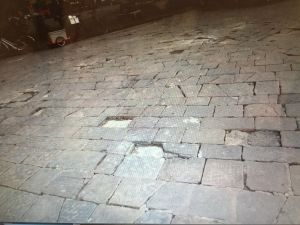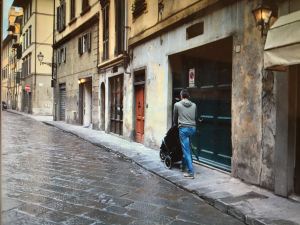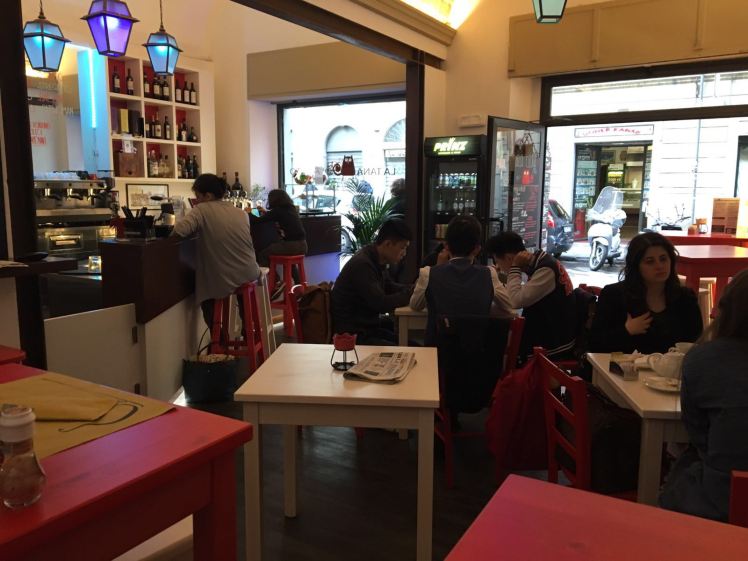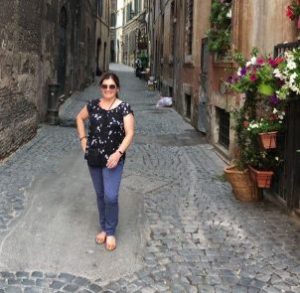As amazing as Florence has been for two weeks, I quite frequently realize my privilege of advanced ability, and if I were differently able, my joy would also be different. My student Sierra White and I discussed this subject, and she helped me with the content of this blog entry.
First, the physical concerns
Taxis, buses, and trams are available, but walking is by far the best mode of transportation since every corner offers a new sight. I admit I’ve ridden a bus only a few times, and the boarding and exiting process is extremely crowded and fast. If I were less physically able, this process could be frustrating. I haven’t seen someone with any kind of assistive equipment try to board a bus, but with so many tourists thinking they must-must-must get to X location fast-fast-fast and packing themselves sweatily into an already packed car, I can’t guess how accommodating the passengers would be for a person needing a bit more time and space; locals, I’m guessing, would make room.

The surface of all streets and sidewalks is cobblestone of varying shapes and wear. For the first day or two, I was pretty careful and feared stumbling, but this sense of instability dissipated soon. However, on the Oltrarno side of the city, I’ve noticed that some of the large street stones can be precariously balancing on an invisible pocket of water and will splash onto my shoes as I step. I can see how the cobblestone surfaces and especially a surprise splash might pose a problem for motorized scooters or any other kind of mobility aids.
Slower-moving folks are likely to experience the same need for caution as in any other city—namely, very fast vehicles that seem to come out of nowhere and often silently due to so many electrically powered vehicles. Also, since Florence is a walking city, cars are not constantly passing, and when one appears, it’s imperative to step onto the often very narrow sidewalk (usually 4-5 feet but sometimes no more than two) on the side of a building. I was nearly hit by a car on my morning walk yesterday; the intersection did not have a stop sign, and pedestrians do not automatically have the right of way here. If I weren’t a generally brisk walker, I might not be writing this blog entry. However, when accidents happen (and I have seen and heard a motorcycle hit the back of a compact car, causing both the rider and the bike to topple over, followed by a crack of the helmet against the cobblestone), ambulances arrive fairly quickly. Based on the high number of sirens I hear every day, I suspect a lot of cars are colliding with other cars and with pedestrians on a regular basis.

Buildings are typically several centuries old, and each floor of these high-ceilinged buildings tends to require from four to eight flights of stairs (many uneven or misshapen from wear). If a person isn’t in fairly good physical condition, these seemingly endless steps can be foreboding. I’ve seen several buildings with retrofitted elevators, such as the AEF building, and these lifts can usually accommodate up to three or four standing individuals. My classroom, for example, is on the third floor, which is accessible by elevator; the students’ apartment is on the third floor of their building, which does not have an elevator. However, if a need is specified in advance, the Florentine folks are compassionate and will accommodate just about any request.
Restrooms in museums or other public sites tend to be located down flights of stairs, and they’re designed in the form of small closets with locking doors instead of stalls. The toilets typically have flushing mechanisms on the top of the tank or on the wall at standing level.
Dietary concerns

I’ve also been happy to see numerous vegetarian and gluten-free options on most menus, and some restaurants (especially pizzeria) include “Gluten Free” in their store signage. What I haven’t seen is any signage for allergens, but ingredients are typically listed on the English-translated menus (and, since the food is typically regional fare, it isn’t packed with the kind of preservatives and artificial ingredients as American food contains).
For diabetics, it’s probably a bit nightmarish with a gelato shop or three on every block along with pastry, gnocchi, and fresh pasta in abundance—deliciously tempting sweets and carbs everywhere.
Sensory concerns
As a bustling city filled with several centuries of art and attractions, Florence could be overwhelming to someone with sensory issues. Since the streets are packed from morning through late evening, there’s a constant cacophony of different languages, and the café businesses tend to play music loudly enough for their guests at sidewalk tables to enjoy. It’s nearly impossible to find a quiet spot, and for those with noise sensitivity or with cochlear implants, I bet it could be quite painful at times.
For seeing- and hearing-impaired visitors, the kind of caution I mentioned above regarding vehicles and sidewalks applies. My students and I have seen some accommodations:At the Fiesole site of Etruscan ruins, I was happy to see part of an interpretive sign in braille, and I saw similar signage in the Uffizi Gallery (a “touch tour”). One of my students saw a vision-impaired person walking on a narrow sidewalk with a companion, who helped him at intersections where the traffic lights did not have accompanying sound signals.
At most of the public sites I’ve visited, I’ve seen folks with headsets following a tour leader (usually €15 or more) or listening to a pre-recorded guide (usually around €5). These extra fees aren’t included in the ticket price (usually around€15). I haven’t seen anyone signing to each other so far.
A major concern of Westerners is the air conditioning—or, in most European cities’ cases, the lack of a/c. After a long day of walking everywhere, including places with many stairs and steep hills, someone who has sensitivity to heat and overexertion would probably find the unrelenting heat difficult to withstand.
Despite coming from Kentucky, where smoking is still a pretty typical habit (25.2% of the adult population), it seems like nearly everyone smokes in Florence, perhaps due to the closer proximity on the sidewalks and streets. When I’ve gotten behind more than one smoker at a time, I’ve had breathing problems. If I hadn’t outgrown my childhood asthma, I bet I’d smother from the amount of second-hand smoke in the city. I still have allergies to smoke, and if I don’t get out of the area quickly, I develop horrible headaches.
Those with tactile issues could find the city sometimes impassable. Since the narrow sidewalks and streets can be crowded with people, it’s hard not to be touched by others, typically through brushing shoulders with a stranger. Another tactile concern is the number of mosquitos in the summer; with no air conditioning, I’ve had to keep at least one window partly open through the night, and as a result, I’ve been devoured by mosquitos on several nights. The result is nearly constant itching and a generous swathing of cortisone cream throughout the day.
In sum
During Disabilities Awareness Week, a banner at EKU says, “We are all temporarily able.” I’ve seen this temporality in my parents as they have gone from being absolutely unstoppable workers and power walkers to cardiac patients who tire far more quickly than ever before and whose pace is significantly slower. They traveled to Europe in the late 1980s as a prize for selling a lot of life insurance, and they returned with a suitcase of chocolate and at least twenty rolls of film showing two vibrant, glowing tourists in front of sites that I wish I could have seen. Thirty years later, I am confident they would still enjoy the sites I’ve visited, but I know they would not share my enthusiasm of walking a minimum of six miles each day. I’d also fear that they would not hear the coming automobiles and would not be quick enough to step out of the way. Yet, I’ve seen plenty of senior citizens in the city who are basking in the lively city’s offerings.
Florence is a fairly typical city in terms of its many challenges for differently abled visitors, but with enough supportive friends and an accommodating host, it’s still a city not to be missed.


First.
LikeLike